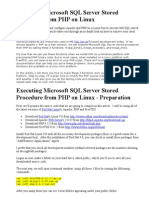How To On Mysql
Uploaded by
Vadiraj JoishHow To On Mysql
Uploaded by
Vadiraj JoishHowto Install MySQL on Linux
This document describes the steps on how to install Mysql on Linux system.Also gives you infomation on few commands which will help to check/identify if the package is already installed r not. Lets start by listing the installed packages in the system. rpm !qa "!qa stands for query all# is the command which will list all the installed packages in the system. $ince it will list the enitre list which is complicated to identify % &e will use grep to sort only the things we want. 'or ex((! rpm !qa )grep !i mysql
* see only one lib file installed. $o lets go ahead and install the mysql using +yum,
$ay +y, to install. The yum will start downloading the pacages through repository ...
-nce the installation is completed. .ou can go ahead and start the service. /ut before that you need to make sure that all the dependency packages are installed which will support the mysql to run without hurdels. $o run yum install mysql0 !y and wait till all the related packages are downloaded and installed.
1ow lets start the mysql service. /etc/init.d/mysqld start
.ou would see a message in the prompt saying(! 2L3A$3 43M3M/34 T- $3T A 2A$$&-45 '-4 T63 My$7L root 8$34 9 To do so% start the server% then issue the following commands(
/usr/bin/mysqladmin !u root password :new!password: /usr/bin/mysqladmin !u root !h localhost.localdomain password :new!password: Alternatively you can run( /usr/bin/mysql;secure;installation $o lets go ahead and reset the password for root to keep it secure. 4un the given command... /usr/bin/mysql;secure;installation
$et the password and remove anonymous users account.
*t is always recommended to disable the root login remotely so say yes and remove the test database. -nce done reload the privilege tables now ...
1ow check the version of mysql by passing the command mysql !<
=onnect to the My$7L database using the root user and make sure the connection is successfull. =ommand(! mysql !u root !p
.ou have sucessfully installed mysql server. (# 'ew commands to manage the service. chkconfig mysqld on " To make it persistant # /etc/init.d/mysql status "to check the status of the service#
/etc/init.d/mysql stop "to stop the service# /etc/init.d/mysql start "to start the service# This document is for beginners on how to install mysql service.. 6appy 3xploring (# <adira> ?oish <adira>>r@ABgmail.com
You might also like
- Installing Steps For Koha Library System On Debian: Installation InstructionsNo ratings yetInstalling Steps For Koha Library System On Debian: Installation Instructions6 pages
- 25 Hardening Security Tips For Linux ServersNo ratings yet25 Hardening Security Tips For Linux Servers9 pages
- Instalar Apache2 Con Php5 Y Mysql en Centos 6.3 (Lamp)No ratings yetInstalar Apache2 Con Php5 Y Mysql en Centos 6.3 (Lamp)10 pages
- Executing Microsoft SQL Server Stored Procedure From PHP On Linux100% (1)Executing Microsoft SQL Server Stored Procedure From PHP On Linux11 pages
- Identify The Group Name of Mysql Packages: How To Install/Upgrade Lamp Using YumNo ratings yetIdentify The Group Name of Mysql Packages: How To Install/Upgrade Lamp Using Yum6 pages
- Install Simplerisk On Ubuntu 22.04 (Apache - Mysql - PHP)No ratings yetInstall Simplerisk On Ubuntu 22.04 (Apache - Mysql - PHP)14 pages
- Oracle Solaris Install Oracle 10g R2 Solaris 10 x86No ratings yetOracle Solaris Install Oracle 10g R2 Solaris 10 x8610 pages
- Start Apache and Mysql at Boot On Kali LinuxNo ratings yetStart Apache and Mysql at Boot On Kali Linux7 pages
- Mysql Installer: Installing Mysql On Windows/ How To Get MysqlNo ratings yetMysql Installer: Installing Mysql On Windows/ How To Get Mysql55 pages
- Qmail Pre-Installation and Total ConfigurationNo ratings yetQmail Pre-Installation and Total Configuration56 pages
- How To Install MySQL 8.0 On CentOS - RHEL 7 - 6 & Fedora 30 - 29 - TecAdminNo ratings yetHow To Install MySQL 8.0 On CentOS - RHEL 7 - 6 & Fedora 30 - 29 - TecAdmin4 pages
- Install LAMP Server (Apache, MySQL, PHP) On RHEL, CentOS, Scientific Linux 6.5 - 6No ratings yetInstall LAMP Server (Apache, MySQL, PHP) On RHEL, CentOS, Scientific Linux 6.5 - 67 pages
- Archlinux 之 之 之 之 Lmap 攻 略 ( 攻 略 ( 攻 略 ( 攻 略 ( 1 、 环 境 准 备 ) 、 环 境 准 备 ) 、 环 境 准 备 ) 、 环 境 准 备 )No ratings yetArchlinux 之 之 之 之 Lmap 攻 略 ( 攻 略 ( 攻 略 ( 攻 略 ( 1 、 环 境 准 备 ) 、 环 境 准 备 ) 、 环 境 准 备 ) 、 环 境 准 备 )16 pages
- Installing Apache, Mysql, and PHP On Linux Compiling ApacheNo ratings yetInstalling Apache, Mysql, and PHP On Linux Compiling Apache5 pages
- Centos 5 and Asterisk 1.4.X Installation Base Install of Asterisk On An I386 Centos/Rhel BoxNo ratings yetCentos 5 and Asterisk 1.4.X Installation Base Install of Asterisk On An I386 Centos/Rhel Box10 pages
- Deployment Commands For Laravel and VueJs Apps On DigitaloceanNo ratings yetDeployment Commands For Laravel and VueJs Apps On Digitalocean10 pages
- Eyeos 2.3 Installation Manual: RequirementsNo ratings yetEyeos 2.3 Installation Manual: Requirements4 pages
- Installing MySQL On Unix Linux Using Generic BinariesNo ratings yetInstalling MySQL On Unix Linux Using Generic Binaries6 pages
- Installation OpenMeetings 5.0.0-M1 On Centos 7 PDF100% (1)Installation OpenMeetings 5.0.0-M1 On Centos 7 PDF18 pages
- Red Hat Security: Linux in Physical, Virtual and Cloud (RH415)No ratings yetRed Hat Security: Linux in Physical, Virtual and Cloud (RH415)10 pages
- Steps_for_an_Installation_of_MySQL_8_4_1734877849No ratings yetSteps_for_an_Installation_of_MySQL_8_4_17348778493 pages
- Boot Ubuntu Via HTTP - FTP Server With Pxe (Diskless Boot) - HabrNo ratings yetBoot Ubuntu Via HTTP - FTP Server With Pxe (Diskless Boot) - Habr6 pages
- Building Your Own Wolfenstein: Enemy Territory Linux Dedicated ServerNo ratings yetBuilding Your Own Wolfenstein: Enemy Territory Linux Dedicated Server6 pages
- Configuration of a Simple Samba File Server, Quota and Schedule BackupFrom EverandConfiguration of a Simple Samba File Server, Quota and Schedule BackupNo ratings yet
- Configuration of a Simple Samba File Server, Quota and Schedule BackupFrom EverandConfiguration of a Simple Samba File Server, Quota and Schedule BackupNo ratings yet
- Installing Steps For Koha Library System On Debian: Installation InstructionsInstalling Steps For Koha Library System On Debian: Installation Instructions
- Instalar Apache2 Con Php5 Y Mysql en Centos 6.3 (Lamp)Instalar Apache2 Con Php5 Y Mysql en Centos 6.3 (Lamp)
- Executing Microsoft SQL Server Stored Procedure From PHP On LinuxExecuting Microsoft SQL Server Stored Procedure From PHP On Linux
- Identify The Group Name of Mysql Packages: How To Install/Upgrade Lamp Using YumIdentify The Group Name of Mysql Packages: How To Install/Upgrade Lamp Using Yum
- Install Simplerisk On Ubuntu 22.04 (Apache - Mysql - PHP)Install Simplerisk On Ubuntu 22.04 (Apache - Mysql - PHP)
- Oracle Solaris Install Oracle 10g R2 Solaris 10 x86Oracle Solaris Install Oracle 10g R2 Solaris 10 x86
- Mysql Installer: Installing Mysql On Windows/ How To Get MysqlMysql Installer: Installing Mysql On Windows/ How To Get Mysql
- How To Install MySQL 8.0 On CentOS - RHEL 7 - 6 & Fedora 30 - 29 - TecAdminHow To Install MySQL 8.0 On CentOS - RHEL 7 - 6 & Fedora 30 - 29 - TecAdmin
- Install LAMP Server (Apache, MySQL, PHP) On RHEL, CentOS, Scientific Linux 6.5 - 6Install LAMP Server (Apache, MySQL, PHP) On RHEL, CentOS, Scientific Linux 6.5 - 6
- Archlinux 之 之 之 之 Lmap 攻 略 ( 攻 略 ( 攻 略 ( 攻 略 ( 1 、 环 境 准 备 ) 、 环 境 准 备 ) 、 环 境 准 备 ) 、 环 境 准 备 )Archlinux 之 之 之 之 Lmap 攻 略 ( 攻 略 ( 攻 略 ( 攻 略 ( 1 、 环 境 准 备 ) 、 环 境 准 备 ) 、 环 境 准 备 ) 、 环 境 准 备 )
- Installing Apache, Mysql, and PHP On Linux Compiling ApacheInstalling Apache, Mysql, and PHP On Linux Compiling Apache
- Centos 5 and Asterisk 1.4.X Installation Base Install of Asterisk On An I386 Centos/Rhel BoxCentos 5 and Asterisk 1.4.X Installation Base Install of Asterisk On An I386 Centos/Rhel Box
- Deployment Commands For Laravel and VueJs Apps On DigitaloceanDeployment Commands For Laravel and VueJs Apps On Digitalocean
- Installing MySQL On Unix Linux Using Generic BinariesInstalling MySQL On Unix Linux Using Generic Binaries
- Installation OpenMeetings 5.0.0-M1 On Centos 7 PDFInstallation OpenMeetings 5.0.0-M1 On Centos 7 PDF
- Red Hat Security: Linux in Physical, Virtual and Cloud (RH415)Red Hat Security: Linux in Physical, Virtual and Cloud (RH415)
- Boot Ubuntu Via HTTP - FTP Server With Pxe (Diskless Boot) - HabrBoot Ubuntu Via HTTP - FTP Server With Pxe (Diskless Boot) - Habr
- Building Your Own Wolfenstein: Enemy Territory Linux Dedicated ServerBuilding Your Own Wolfenstein: Enemy Territory Linux Dedicated Server
- Configuration of a Simple Samba File Server, Quota and Schedule BackupFrom EverandConfiguration of a Simple Samba File Server, Quota and Schedule Backup
- Configuration of a Simple Samba File Server, Quota and Schedule BackupFrom EverandConfiguration of a Simple Samba File Server, Quota and Schedule Backup



























































